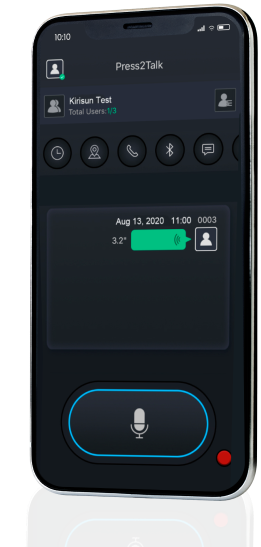Push To Talk
communication -
How does it work?
Understand how PTT works, its benefits, the difference between PTT and Push to Talk Over Cellular (PoC), and the practical applications of PTT across various sectors.
As the world becomes more interconnected, communication technologies continue to evolve to meet the growing needs of users. Among these technologies, Push to Talk (PTT) has emerged as a reliable means of instant communication, particularly favored in professional settings.
We’ll discuss the workings of PTT, compare traditional PTT with the more recent Push to Talk Over Cellular (PoC), and iCallx’s remarkable PoC solution, Press2Talk Global PTT Services. This article offers valuable insights into the influential role of PTT in today’s communication landscape.
What is Pusht To Talk?
Push to Talk (PTT) is a communication method that allows a person to communicate in a conversation by simply pressing a button to send a message and releasing it to receive one. Often likened to a two-way radio, this system is used in telecommunications and radio technology.
PTT offers real-time transmission, making it an effective tool for immediate and clear conversations. Popular in professional settings, Push to Talk is commonly integrated into walkie-talkies, cell phones, conferencing systems, and even on certain social media platforms for its efficiency and convenience.
These are our products
These are our products
How does PTT work?
This half-duplex communication, where only one party can transmit at a time, ensures clear and uninterrupted conversations. Also, It’s important to note that PTT services can operate over various networks including cellular, Wi-Fi, Broadband, and even satellite, thus providing flexibility and wide coverage.
Differences between Push To Talk and Push To Talk Over Cellular
Push to Talk (PTT) and Push to Talk Over Cellular (PoC) are two communication technologies that allow instant communication at the push of a button. The main difference between them lies in the network infrastructure they use.
PTT, which is older, requires a dedicated radio network to operate, limiting its use to short distances and in areas with adequate radio coverage. PoC, on the other hand, uses existing cellular networks for voice transmission, enabling much greater coverage, often on a global scale.
In addition, PoC can support a variety of additional functionalities, such as instant messaging, file sharing, and GPS location, which are not available in the traditional PTT system.
Our PoC solution
Some of the advantages of wireless communication for our software include:
- Support Many Voice Coder, HD voice, Individual Calls, Group Calls, Interrupt, and Other Functions
- Support Multiple Languages
- Support the Transmission of Text, Messages, Pictures and Videos
- Support A-GPS Positioning, Uploading, and Checking Member’s Location Function
- Support Connecting with Bluetooth Earphone, Bluetooth Hand-Microphone, and Other External Devices
Press2Talk
iCallx PoC solution is a radio communication system based on (3G/4G) mobile networks and Wi-Fi, providing high efficient and reliable critical communication with dispatch features for enterprises, institutions, utilities, and more.

What Push to Talk is used for? - Real World applications
The real-world applications of Push to Talk (PTT) are extensive and practical across various sectors:
- Health care: PTT devices allow for seamless and quick communication among medical teams, enhancing patient care and emergency response times.
- Emergency services (rescue, fire departments, police, etc.): this system is invaluable for coordinating responses to crisis situations where every second counts.
- Education sector: maintaining effective communication within the school environment, enhancing safety, and streamlining operations.
- Transportation and logistics industry: help in coordinating freight movement, tracking deliveries, and ensuring timely responses to changes in plans.
- Construction and manufacturing: Push to Talk is essential in ensuring safety, improving coordination, and increasing efficiency on the job site.
As it is notorious, all these applications have to do with coordination and security (logistics), so their uses can be extrapolated to any sector that requires security and secure and immediate communication.

